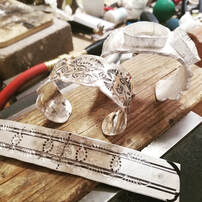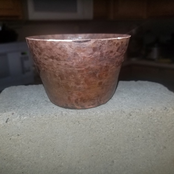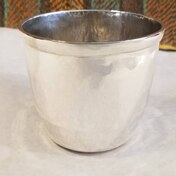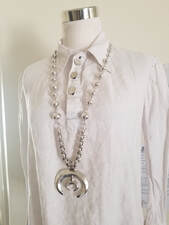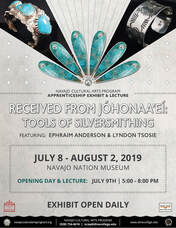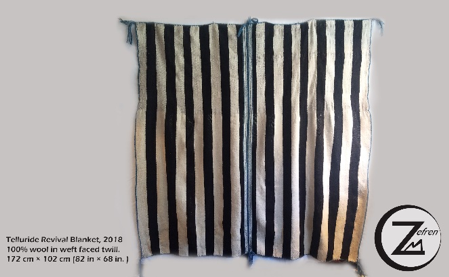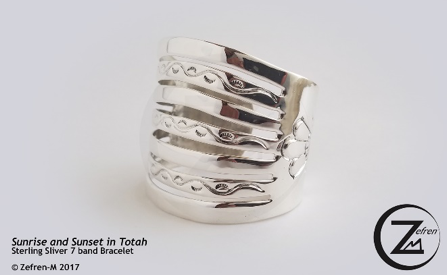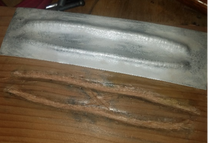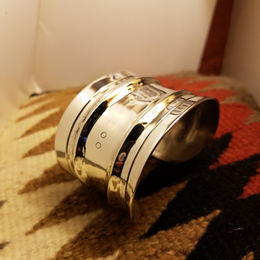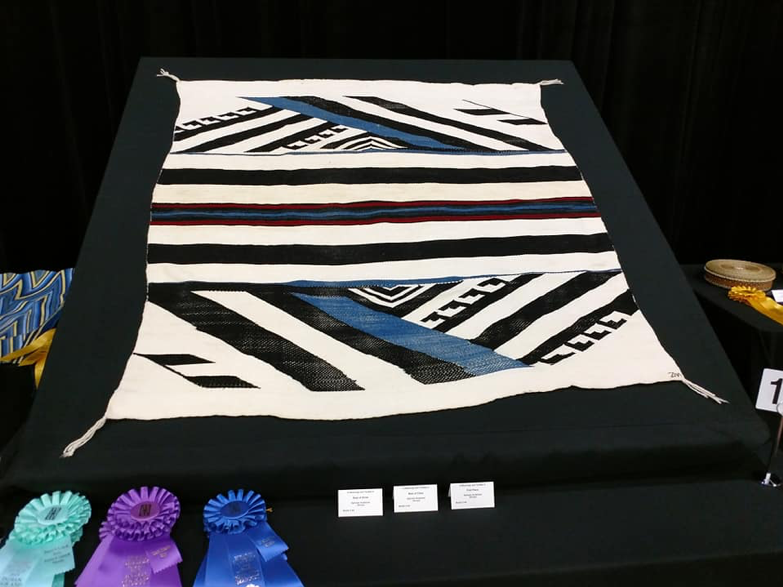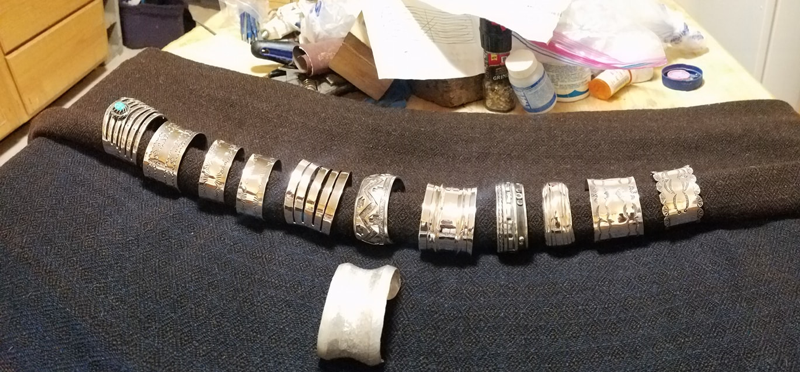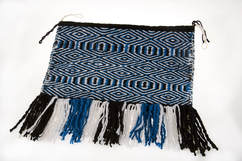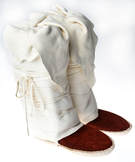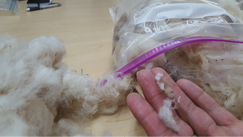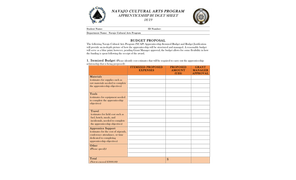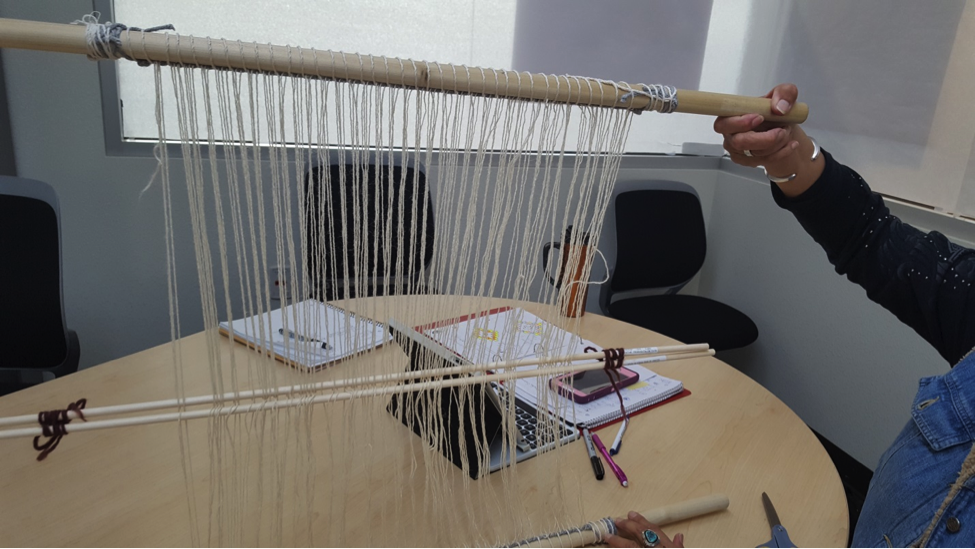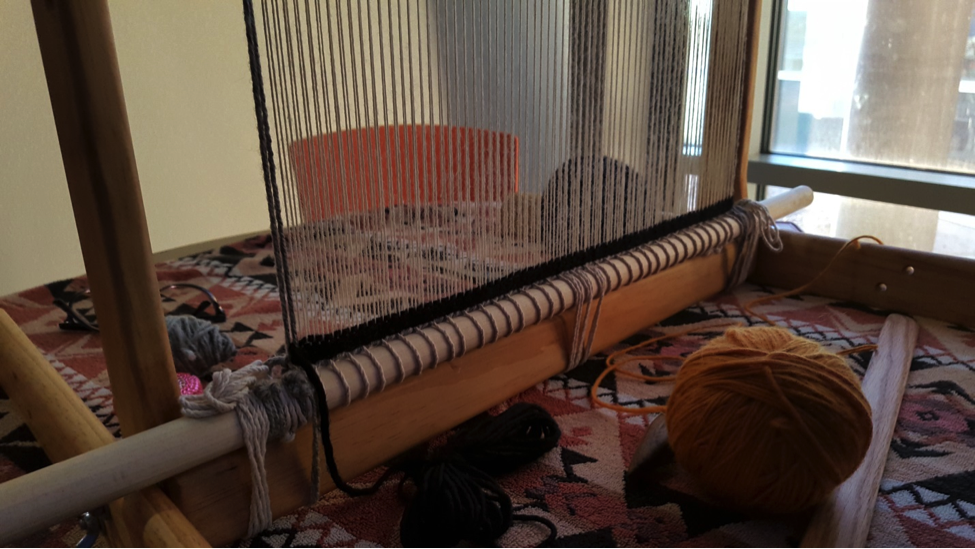Zefren AndersonNCAC Apprentice 2018/19 (Silversmith)
I didn't have to imagine. This was my reality this Spring 2019. My Choice? I wanted to take my silversmithing skills to another level, work with heavy gauges of silver, and sell my work alongside my weavings. Who was there to help me? Lyndon Tsosie and the NCAP Apprenticeship Program. At Lyndon’s shop, I became comfortable working on basic chains. And as time passed and with Lyndon's help, I learned how to make heavier jewelry as well as jewelry that was lighter for everyday wearing. I also focused a lot on my design. Lyndon’s tips and knowledge on raising metal allowed me to reach a new level of skill and aesthetic. So here is what I learned...
The attentive master jeweler, Lyndon, would wait until I asked a hard question or expressed frustration at what I was doing. Those lessons received and tips became part of my tools. Lyndon taught me that he was a tool as well. He would say: “I’m a tool here and that is how you are going to learn more than I can teach in my entire lifetime because everything around you can teach you and can be tools. So respect them and keep learning.” Working with thick gauges of 10 or lower, learning how to manage the heat properly, and selecting the correct tools were great take aways from my time as an apprentices. As my supply list grew prepared myself to raise silver into a vessel perhaps a cup or tumbler. A bigger torch, heavier hammers, anvils and several copper plates contributed to my practice sessions. While the NCAP provided funds for this journey, I had to learn how to budget so I only had enough left to purchase one silver 6x6 18 gauge piece for the final piece. After four weeks of visiting Lyndon and finding some weaving time in between visits, I completed the final assembly of my necklace and I did my final buff on the bracelets. Then the challenge began - I started raising the sliver. Every day, for 5 days, I was working at least 6 hours on the hammer work of the cup, slowly coaxing the sliver from flat sheets to organic vessel. Every course needed annealing and every morning my hands and arms would ache and cramp but I pushed through finally knowing that it takes all your tools, used properly and with respect to shape art. The cup was simple but I became more than just a cup with every hammer blow and cramp. Then... it was all over. The pieces were done. But before I turned the pieces in for my mini exhibit, it was time for critique of their style and wear. Positive reviews all around with remarks that the pieces that are heavy are rightfully so and that pieces that look heavy were surprising lighter than expected, which attest to their value as a everyday wearer jewelry. The biggest critics were from the NCAP grant manager, Christine Ami and my mentor Lyndon Tsosie who both ran a list down of the stages where I could have done better but complimented on the execution for a new silversmith. Their last words were of encouragement and of how being pushed will tighten the bar between novice and master craftsperson. They reminded me that I should reward all the hours, pain, perseverance, devotion to design and crafting with a good life. Just like the first lesson, the first tool I was given the principal of Sa'ah Naagháí Bik'eh Hozhóón from Wilson Aronlith. So I look forward to more as I continue to work with Diné College and The Navajo Cultural Arts Program. Thank You! AND... Stop by to check out the creations I made during my apprenticeship at the Navajo Nation Museum from July 8 - August 2, 2019. Opening Night will be July 9th from 5-8pm. The title of my exhibit will be "Received from Jóhonaa’éí: Tools of Silversmithing." I hope to see you all there !
1 Comment
Zefren AndersonNCAP Apprentice 2018/19 (Silversmith) I was only seeking cultural knowledge to back my weaving when I first joined the Navajo Cultural Arts Certificate Program in 2017. The program required that I select an emphasis area and at the time I wasn’t looking to expand my artistic ability past weaving. But I also recognized that silversmithing was an option in the program. A small moment of self-doubt, much like when I first filled out the application for NCAP went through my mind. As I contemplated adding silversmithing as an emphasis area, I asked myself, “was this going to worth my time away from my loom, friends and family?” The possibilities of “what if?” were at first negative - "what if it takes away from my weaving? what if I am not good enough?" I signed up anyway for my silversmithing classes with Wilson Aronilth and looking back on that decision...my :what ifs" have become “what if I had not?” Every class, mentor and event that NCAP included only strengthened my understanding of K'é, which is both a Navajo philosophy and Navajo skill. Those moments of self-doubt are no longer signs of weakness but great turning points where life changing decisions are made. By the end of the program, my weaving did not suffer - I received the Legacy of a Master Weaver award for my stripped blanket at the 2018 NCAP Exhibit. I took a gambled with that rug - another area of self doubt - my decision of reviving older styles of weaving. And guess what....my gamble selecting a second emphasis area paid off. Starting with sheet of 3x6" sterling silver plate during the cohort I received a ribbon for a simple split shank bracelet. They were recognized by established silversmiths and weavers as great examples of Navajo Art even though I didn’t feel like they were. To me, they were just small aberrations in the cosmos that is Human existence. Fast forward to 2019 and I’m now an expert at trudging past the small pauses of why? NCAP did that. The Program gave me the ability to plan and work independently while developing relationships that strengthen Navajo culture. I find myself doing activities outside my comfort zone with a Certificate of Navajo Cultural Arts in hand. I’m doing this while also continuing to weave full time for Native American art Shows and being a caregiving to my father. Life didn't stop me from applying and receiving a NCAP Paid Apprenticeship. Through that gamble I was given the opportunity to learn from Lyndon Tsosie, a world renowned Navajo Silversmith and owner of the House of Stamps in Gallup. Little did I know at the time that his advice would have life altering affirmations of the path NCAP put me on. “You have to earn your chops” and “believe in your work as you design it, not as the experts defines it” Those are the central lessons I learned from Lyndon as we both concentrated on the 61stHeard Museum Guild Indian market and Art show. During my time with Lyndon, I asked about older techniques and styles of Navajo Jewelry and Lyndon responded with a trove of knowledge and experiences that I have yet to utilize personally. But I have learned that with the simplest tools, great art can be created, nurtured and shown to hold its beauty among others styles. Another moment of self-doubt - Submission time to the Heard. I was fully prepared to defend my work. I had three weaving pieces to submit with one sliver bracelet- A total of 4 pieces but the limit was 3. For a split second, I wanted to switch out my weakest weaving for my bracelet as the other two weavings were made for the expected standards of Navajo textiles. My weakest piece was an experiment and broke almost every rule of the standard of Navajo weavings. A split second later, I walked out with my bracelet and I left my atypical, experimental weaving to be juried. What if I had NOT! That experiment - that piece that I thought had the weakest possibility of placing - Won best of Show at the 61st Heard Museum Guild Indian market and Art show. I brought home ribbons and an empty bracelet case. Even a half done bracelet that wasn’t buffed sold! I urged the client to wait until I had polished the edges with a rock making a comfortable hand formed bracelet for them. Now I understand having integrity in one’s art even if it’s different because if you work at making it the best it can be it will support you and someone will find it beautiful. I’m am excited to see what happens next because... what if I had NOT?! Sue V. Begay 2017/18 Apprentice Hi blog readers! Do you remember me?! My name is Sue V. Begay an Emerging Navajo Artist from Dennehotso, AZ-Navajo Nation-USA. I am a proud member of the Navajo Nation. My clans are the Hashtl’ishnii clan born for the Kinyaa’aanii, my grandfathers are the Tabaaha and paternal grandfathers are the Kinlichii’nii. You may remember me from the 2017/18 Navajo Cultural Arts Certificate Cohort – I was learning the cultural art of Moccasin Making and enhancing my skills in Weaving. Last year, my moccasins “White Shell Woman” took home the Board of Regents’ Choice Award at the 2017 Navajo Cultural Arts Exhibit. I am now in the NCAP Apprenticeship Program and under the guidance of Master Weaver TahNibaa Naataanii. The Apprenticeship Program is for NCAC graduates like myself who want to continue their learning in a more specialized fashion. During the application process, we submit interest to work one-on-one with a mentor. This is my fifth week in the apprenticeship. I can honestly say that my learning about weaving has grown tremendously since day one when I met with TahNibaa and her mother Sara. That day we spent getting to know each other – our strengths (and my weaknesses). It’s a good thing I know when to ask questions – because I sure had a lot of them! My first lesson was on terminology. I didn’t know what some of the rug weaving terms were and I got a quick lesson that first day. The vocabulary words that I learned are the “S” and the “Z” twists, rolags, skein, fine weight, medium weight, and heavy weight.
With TahNibaa’s assistance, I ordered my a Niddy Noddy, drop spindle, and carding tool for myself. If you are going to do things right – you need to have your own tools, she stresses. This way I can practice at home the proper way of handling my spindle. With the tools ready, I learned how to do the “Navajo three ply,” which is also called the “chain”. I learned how to do the “Andean wrap” on my hand. And with those first meetings under my belt, I was sent off with more homework – to use those techniques to make the edge cords of one of my rugs.
Things that I learned are going to help with my future rugs. Proper warping and how to “dress a rug” have been just a few of the techniques that I have learned. All this new knowledge, I just soak up the information like the wool soaks up the water. I can only get better and I plan to work hard at the skills that were introduced to me. NCAPERS (Alumni and Current), if you are (1) a NCAC graduate or will be by Summer 2018 and (2) are interested in the being an apprentice, you should check out the NCAP website for the Apprenticeship Program. The application period for the Apprenticeship Program has just opened and will close April 20th!
|
Categories
All
Archives
October 2021
|
SocialsALL PHOTOS IMAGES ARE COPYRIGHT PROTECTED. PHOTO IMAGES USE IS SUBJECT TO PERMISSION BY THE NAVAJO CULTURAL ARTS PROGRAM. NO FORM OF REPRODUCTION IS PERMITTED WITHOUT WRITTEN PERMISSION FROM THE NAVAJO CULTURAL ARTS PROGRAM. |
Featured Pages |

